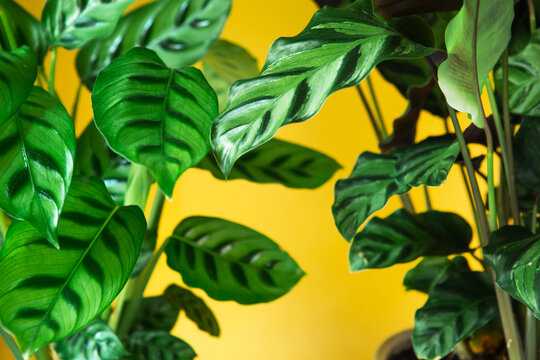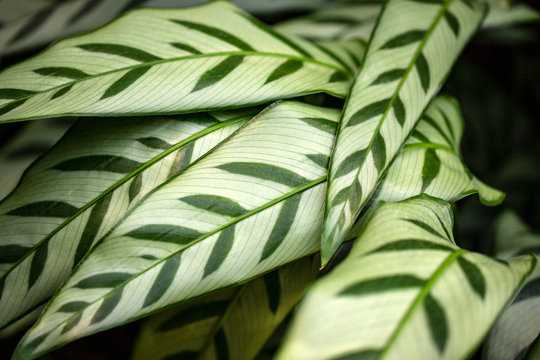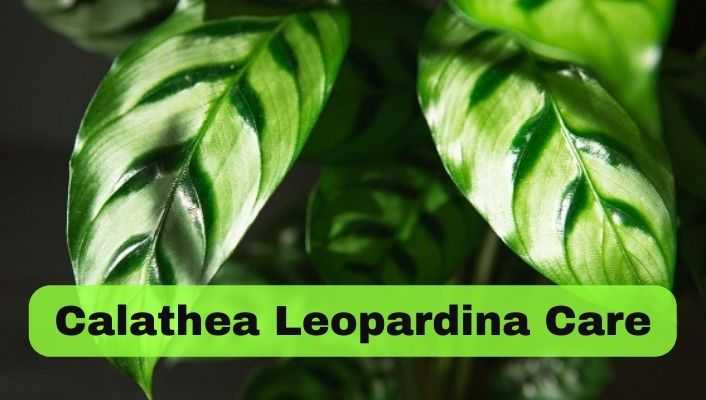Calathea Leopardina is a beautiful plant that is perfect for collectors looking to add to their collections. The foliage on this plant is impressive, making it one of the most beautiful tropical plants.
The leaves of this plant are a beautiful bright green spade-shaped shape. Moreover, it has an interesting and vibrant spot-like pattern in deep green. The main reason for its name is its spotted pattern.
If you follow the instructions, Calathea leopardina care is easy, just like other Calathea varieties. This plant has long, upright stems with fan-shaped leaves that provide a unique display for any space. Plant enthusiasts will find this plant to be the ideal houseplant.
Post Contents
- Calathea Leopardina Origin & Overview:
- Size:
- Growth Rate:
- Calathea Leopardina Care and Maintenance:
- Soil Mixture:
- Water Requirements for Calathea Leopardina Care:
- Fertilizer Requirements:
- Temperature Requirements:
- Light Requirements:
- Humidity Requirements:
- Repotting:
- Pruning the Calathea Leopardina:
- Calathea Leopardina Propagation:
- Plant Toxicity Information:
- Frequently Asked Questions (FAQs):
- Conclusion:
- Author
Calathea Leopardina Origin & Overview:
It belongs to the Marantaceae family and is native to South America, but is most commonly found in Brazilian rainforests.

Calathea Leopardina is a prayer plant meaning that its leaves follow a circadian rhythm, opening each morning and closing again every night. Unlike other Calatheas, the Calathea Leopardina adapts more easily to new environments.
Discover interesting facts about Calathea Leopardina, such as its name, family, native region, and care instructions.
| Information | Description |
|---|---|
| Common Name | Calathea Leopardina |
| Scientific Name | Calathea leopardina |
| Family | Marantaceae |
| Native to | Brazil |
| Growth Habit | Herbaceous perennial |
| Leaf Pattern | Elliptical with dark green spots |
| Leaf Color | Dark green with light green spots |
| Light | Medium to bright indirect light |
| Watering | Keep soil consistently moist |
| Humidity | Requires high humidity levels |
| Temperature | Prefers warm temperatures (18-26°C) |
Related Post: Mastering Calathea Louisae Care: (Expert Tips)
Size:
The stems of the Calathea Leopardina can grow straight, and they can reach a height of 2 feet (60cm).
Its leaves can grow up to 5 to 7 inches (12-17cm) long.
Growth Rate:
If you provide the plant with suitable conditions, you will notice a moderately fast growth rate. The plant will reach its full size in only a few years.
Calathea Leopardina Care and Maintenance:
This plant is said to be a good adapter, and less care is required, but the Calathea Leopardina still has certain requirements.
Being a low-maintenance plant, it needs less attention. But we recommend you check the key points, including soil mix, light, water, fertilizer, and ideal temperature and humidity. This will strongly encourage the plant towards strong growth.
Soil Mixture:
The best way to keep your Leopardina happy and strong is by potting it in an airy soil mixture and light. The soil should not retain water and should quickly drain.
Too much moisture and sogginess can lead to many issues, including root rot and plant death. We recommend always keeping your soil from getting waterlogged. Moreover, ensure that the soil is rich in nutrients.
We recommend mixing your medium for the Calathea Leopardina; we have included some common soil mixing items below:
- 50% potting soil (or coco coir)
- 20% orchid bark
- 20% activated charcoal
- 10% perlite
Water Requirements for Calathea Leopardina Care:
The Calathea Leopardina can get a bit tricky when the care comes to watering.
It’s confusing that the plant loves moisture, but at the same time, it shouldn’t get waterlogged. Now to make you understand, always check the top inch of your soil when watering the plant.
If it feels dry, you should water the plant, but if it’s moist, there is no need to do it because overwatering will cause waterlogged soil that can lead to bacterial leaf spots as well as dreaded root rot.

Never stick to a water routine; instead, we highly recommend learning to spot when your plant needs water.
Some common ways to tell that your plant needs water are:
- Drooping Leaves
- The top 1-2 inches of soil are dry to touch
- Yellowing or Browning Edges (though this can have other causes too!)
- Wrinkling or ruching of leaves
Also Read: Calathea Flamestar Care Tips (For Perfect Growth)
Fertilizer Requirements:
If you want the plant to grow strong and sturdy, then opt for a complete nutrient fertilizer or an all-purpose houseplant fertilizer.
Make the fertilizer diluted in water and add it directly into the plant’s soil. This will help to make it reach all the places inside the soil.
Moreover, please do not use too much fertilizer as it can burn the roots. Always fertilize during the growing season and stop during cold seasons.
Temperature Requirements:
One of the most important parts of calathea leopardina care is providing the appropriate temperature. You have to duplicate the rainforest environment.
If you want perfect growth, provide the plant with temperatures that range between 18°-30°C (65°-85°F).
Always try to avoid low temperatures because they can cause the plant to result in stunted growth, shock, or possibly even death of your plant.
Moreover, always keep your Calathea Leopardina away from drafts, vents, windows, or A/C units because sudden temperature changes can leave the plant in shock.
Light Requirements:
Calathea Leopardina grows under its natural habitat’s thick and bright forest shade. So this means that you have to avoid direct sunlight.
Direct light can make your plant’s leaves fade and become damaged. The plant also gets dehydrated in direct sunlight.
The perfect light conditions for Leopardina are medium or even lower light, along with a shady environment. But remember not to make the environment completely dim.
It can easily grow in a kitchen, bathroom, bedroom or wherever you desire. But ensure that they are bright enough.
We always recommend placing your plant near a window that faces north. It is ideal for these kinds of plants.
Humidity Requirements:
We recommend keeping the humidity levels at 80% because Calathea Leopardina is a tropical plant, and its native environment has high humidity levels.
The main indication that your plant is not receiving the right humidity is that the leaves of your plant will get a little dry and crispy.
It is recommended to invest in an inexpensive hygrometer. Using it will help you keep a check on the humidity levels of your room.
If the humidity levels stay low, then buy a small humidifier. It will keep the levels in a suitable condition.
Moreover, you can move your plant to humid places like your laundry room or kitchen or try grouping your plants to increase humidity resource sharing naturally.
Repotting:
Next step is repotting of the plant. It plays an essential role in calathea leopardina care. The Calathea Leopardina should be transplanted every 1-2 years. Be sure to upgrade to a slightly bigger pot when you see signs like roots emerging from the drainage holes. Or the roots are getting root bound.
Remember to do so at the beginning of the growing season, in Spring or early Summer. We recommend adding a new and fresh potting mix.
Pruning the Calathea Leopardina:
In terms of pruning, just cutting them off is better if you see yellow, browning or damaged leaves. If the plant doesn’t have this, there is no need to prune your plant.
Always use a sterilized pair of clippers to remove them from your plant. You can also get rid of infected parts of the plant.
These leaves hinder your plant’s growth, as its energy is constantly wasted on them.
Calathea Leopardina Propagation:
The propagation routine of this plant can be different from other Calathea varieties. The process is quite easy as it is the same for many plants.
Like most kinds of Calathea, the Leopardina is propagated by division. You must dig up the plant, divide it into smaller sections using a sterilized tool, and then have multiple plants in a pot. In addition, for calathea leopardina care, you must focus on propagation.
Plant Toxicity Information:
Calathea Leopardina is not toxic to pet animals or small children. But still, you should keep it out of reach because swallowing any plant can lead to an upset stomach.
Frequently Asked Questions (FAQs):
Why is my Calathea Leopardina drooping?
If the leaves droop, this might be a water or temperature fluctuation.
Double-check everything, and you will understand the reason behind it. Then go for the right solution.
Does Calathea Leopardina produce flowers?
These plants grow flowers in their natural habitat, but it isn’t easy to obtain flowers in indoor environments.
Conclusion:
We hope you found all the necessary information you were looking for. We recommend this plant for beautifying your home as it is easy to care for. Moreover, it has a lot of characteristics, so every plant lover should give it a try.
It would be best to visit any garden supply or plant store to buy this plant. Be sure to buy and care for one of these. Best of Luck!
Read More Articles:
Calathea Fasciata Plant Care (Tips for Best Growth)

